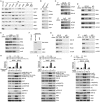mTORC2 promotes type I insulin-like growth factor receptor and insulin receptor activation through the tyrosine kinase activity of mTOR
- PMID: 26584640
- PMCID: PMC4816127
- DOI: 10.1038/cr.2015.133
mTORC2 promotes type I insulin-like growth factor receptor and insulin receptor activation through the tyrosine kinase activity of mTOR
Abstract
Mammalian target of rapamycin (mTOR) is a core component of raptor-mTOR (mTORC1) and rictor-mTOR (mTORC2) complexes that control diverse cellular processes. Both mTORC1 and mTORC2 regulate several elements downstream of type I insulin-like growth factor receptor (IGF-IR) and insulin receptor (InsR). However, it is unknown whether and how mTOR regulates IGF-IR and InsR themselves. Here we show that mTOR possesses unexpected tyrosine kinase activity and activates IGF-IR/InsR. Rapamycin induces the tyrosine phosphorylation and activation of IGF-IR/InsR, which is largely dependent on rictor and mTOR. Moreover, mTORC2 promotes ligand-induced activation of IGF-IR/InsR. IGF- and insulin-induced IGF-IR/InsR phosphorylation is significantly compromised in rictor-null cells. Insulin receptor substrate (IRS) directly interacts with SIN1 thereby recruiting mTORC2 to IGF-IR/InsR and promoting rapamycin- or ligand-induced phosphorylation of IGF-IR/InsR. mTOR exhibits tyrosine kinase activity towards the general tyrosine kinase substrate poly(Glu-Tyr) and IGF-IR/InsR. Both recombinant mTOR and immunoprecipitated mTORC2 phosphorylate IGF-IR and InsR on Tyr1131/1136 and Tyr1146/1151, respectively. These effects are independent of the intrinsic kinase activity of IGF-IR/InsR, as determined by assays on kinase-dead IGF-IR/InsR mutants. While both rictor and mTOR immunoprecitates from rictor(+/+) MCF-10A cells exhibit tyrosine kinase activity towards IGF-IR and InsR, mTOR immunoprecipitates from rictor(-/-) MCF-10A cells do not induce IGF-IR and InsR phosphorylation. Phosphorylation-deficient mutation of residue Tyr1131 in IGF-IR or Tyr1146 in InsR abrogates the activation of IGF-IR/InsR by mTOR. Finally, overexpression of rictor promotes IGF-induced cell proliferation. Our work identifies mTOR as a dual-specificity kinase and clarifies how mTORC2 promotes IGF-IR/InsR activation.
Figures









References
-
- Robitaille AM, Christen S, Shimobayashi M, et al. Quantitative phosphoproteomics reveal mTORC1 activates de novo pyrimidine synthesis. Science 2013; 339:1320–1323. - PubMed
-
- Jacinto E, Loewith R, Schmidt A, et al. Mammalian TOR complex 2 controls the actin cytoskeleton and is rapamycin insensitive. Nat Cell Biol 2004; 6:1122–1128. - PubMed
Publication types
MeSH terms
Substances
LinkOut - more resources
Full Text Sources
Other Literature Sources
Miscellaneous

